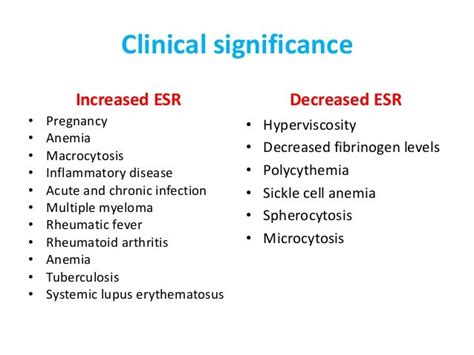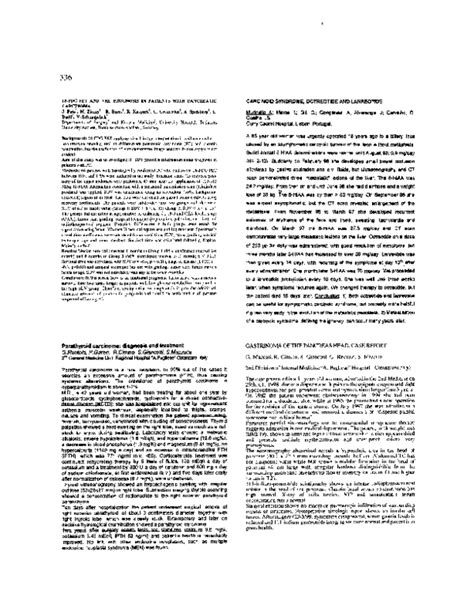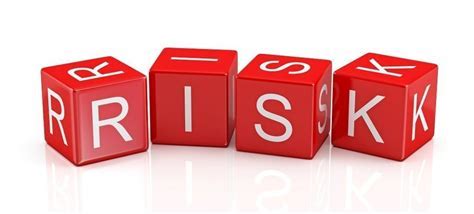Intro
Elevated sed rate symptoms include inflammation, fatigue, and fever. Discover 5 key indicators of high erythrocyte sedimentation rate, such as joint pain and swelling, and learn about related conditions like anemia and autoimmune disorders.
Elevated sedimentation rate, or sed rate, is a blood test that measures how quickly erythrocytes (red blood cells) settle at the bottom of a test tube containing a blood sample. It indirectly measures how much inflammation is in the body. The sed rate is also known as the erythrocyte sedimentation rate (ESR). A high sed rate can be an indicator of various underlying health conditions, and it is essential to understand the symptoms associated with an elevated sed rate to seek medical attention promptly.
The sed rate test is a non-specific measure of inflammation, meaning it can be elevated in various conditions, including infections, autoimmune disorders, and cancers. The test is often used in conjunction with other diagnostic tests to determine the underlying cause of the elevated sed rate. An elevated sed rate can be a sign of a severe underlying condition, and it is crucial to consult a healthcare professional for proper diagnosis and treatment.
An elevated sed rate can manifest in different ways, depending on the underlying condition causing the inflammation. Some common symptoms associated with an elevated sed rate include fatigue, weight loss, and loss of appetite. These symptoms can be non-specific and may be similar to those experienced with other conditions, making it essential to consult a healthcare professional for a comprehensive evaluation. In some cases, an elevated sed rate may not produce any noticeable symptoms, and the condition may be diagnosed during a routine medical examination or when testing for other conditions.
Elevated Sed Rate Symptoms

The symptoms of an elevated sed rate can vary depending on the underlying condition causing the inflammation. Some common symptoms include:
- Fatigue and weakness
- Weight loss and loss of appetite
- Fever and chills
- Joint pain and swelling
- Skin rash or lesions
- Eye problems, such as dryness or redness
- Hair loss
- Numbness or tingling in the hands and feet
Causes of Elevated Sed Rate
The causes of an elevated sed rate can be divided into several categories, including: * Infections, such as bacterial or viral infections * Autoimmune disorders, such as rheumatoid arthritis or lupus * Cancers, such as lymphoma or multiple myeloma * Inflammatory conditions, such as Crohn's disease or ulcerative colitis * Trauma or injury, such as a car accident or a fallDiagnosis and Treatment

The diagnosis of an elevated sed rate typically involves a physical examination, medical history, and laboratory tests. The sed rate test is often used in conjunction with other diagnostic tests, such as a complete blood count (CBC) or a blood chemistry test, to determine the underlying cause of the elevated sed rate. The treatment of an elevated sed rate depends on the underlying condition causing the inflammation. In some cases, the elevated sed rate may resolve on its own, while in other cases, treatment may be necessary to manage the underlying condition.
Treatment Options
The treatment options for an elevated sed rate depend on the underlying condition causing the inflammation. Some common treatment options include: * Medications, such as nonsteroidal anti-inflammatory drugs (NSAIDs) or corticosteroids * Antibiotics or antiviral medications to treat infections * Chemotherapy or radiation therapy to treat cancer * Lifestyle changes, such as getting regular exercise or following a healthy diet * Alternative therapies, such as acupuncture or massage therapyComplications and Risks

An elevated sed rate can increase the risk of complications, such as:
- Organ damage, such as kidney or liver damage
- Increased risk of infection
- Increased risk of cancer
- Increased risk of cardiovascular disease
- Increased risk of osteoporosis
Prevention and Management
Preventing and managing an elevated sed rate involves addressing the underlying condition causing the inflammation. Some strategies for preventing and managing an elevated sed rate include: * Getting regular medical check-ups * Following a healthy diet and exercise routine * Managing stress and anxiety * Avoiding smoking and limiting alcohol consumption * Getting enough sleep and practicing good sleep hygieneNatural Remedies

Some natural remedies may help reduce inflammation and manage an elevated sed rate. These remedies include:
- Turmeric, which contains curcumin, a powerful anti-inflammatory compound
- Ginger, which has anti-inflammatory properties
- Omega-3 fatty acids, which can help reduce inflammation
- Probiotics, which can help maintain a healthy gut microbiome
- Acupuncture, which can help reduce stress and anxiety
Dietary Changes
Dietary changes can also help manage an elevated sed rate. Some dietary changes include: * Eating an anti-inflammatory diet, which includes foods rich in fruits, vegetables, and whole grains * Avoiding foods that can trigger inflammation, such as processed meats and sugary drinks * Drinking plenty of water and staying hydrated * Limiting caffeine and alcohol consumption * Eating foods rich in omega-3 fatty acids, such as fatty fish and nutsConclusion and Next Steps

In conclusion, an elevated sed rate can be a sign of an underlying health condition, and it is essential to consult a healthcare professional for proper diagnosis and treatment. By understanding the symptoms, causes, and treatment options for an elevated sed rate, individuals can take steps to manage their condition and reduce the risk of complications. If you have concerns about your sed rate or are experiencing symptoms, consult a healthcare professional for personalized advice and treatment.
What is an elevated sed rate?
+An elevated sed rate is a blood test result that indicates inflammation in the body. It is a non-specific measure of inflammation, meaning it can be elevated in various conditions, including infections, autoimmune disorders, and cancers.
What are the symptoms of an elevated sed rate?
+The symptoms of an elevated sed rate can vary depending on the underlying condition causing the inflammation. Common symptoms include fatigue, weight loss, and loss of appetite, as well as joint pain and swelling, skin rash or lesions, and eye problems.
How is an elevated sed rate diagnosed and treated?
+The diagnosis of an elevated sed rate typically involves a physical examination, medical history, and laboratory tests. The treatment of an elevated sed rate depends on the underlying condition causing the inflammation and may involve medications, lifestyle changes, or alternative therapies.
Can an elevated sed rate be prevented or managed?
+Preventing and managing an elevated sed rate involves addressing the underlying condition causing the inflammation. Strategies for prevention and management include getting regular medical check-ups, following a healthy diet and exercise routine, managing stress and anxiety, and avoiding smoking and limiting alcohol consumption.
What are some natural remedies for an elevated sed rate?
+Some natural remedies that may help reduce inflammation and manage an elevated sed rate include turmeric, ginger, omega-3 fatty acids, probiotics, and acupuncture. Additionally, dietary changes, such as eating an anti-inflammatory diet and avoiding foods that can trigger inflammation, can also help manage an elevated sed rate.
We hope this article has provided you with a comprehensive understanding of elevated sed rate symptoms, causes, and treatment options. If you have any further questions or concerns, please do not hesitate to comment below or share this article with others who may find it helpful. Remember to consult a healthcare professional for personalized advice and treatment if you are experiencing symptoms or have concerns about your sed rate.
